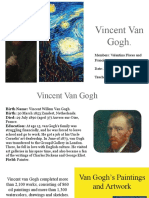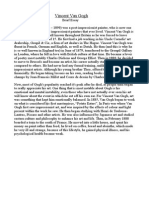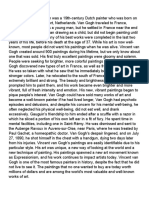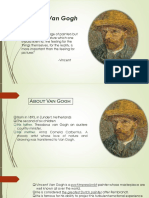0 ratings0% found this document useful (0 votes)
32 viewsArtist Paper
Artist Paper
Uploaded by
api-319269203Vincent van Gogh was a Dutch post-Impressionist painter born in 1853 who struggled to find his calling before dedicating himself to art at age 27. He was self-taught and painted scenes of everyday life with bright colors and emotional depth. Though he sold few paintings during his lifetime, van Gogh is now considered one of the most famous and influential artists of all time. His 1889 portrait of his friend Joseph Roulin uses contrasting colors and a compelling gaze to capture the essence of its subject. Van Gogh's artwork brought new meaning and beauty to ordinary scenes and inspired other artists to convey emotion and spirituality.
Copyright:
© All Rights Reserved
Available Formats
Download as DOCX, PDF, TXT or read online from Scribd
Artist Paper
Artist Paper
Uploaded by
api-3192692030 ratings0% found this document useful (0 votes)
32 views8 pagesVincent van Gogh was a Dutch post-Impressionist painter born in 1853 who struggled to find his calling before dedicating himself to art at age 27. He was self-taught and painted scenes of everyday life with bright colors and emotional depth. Though he sold few paintings during his lifetime, van Gogh is now considered one of the most famous and influential artists of all time. His 1889 portrait of his friend Joseph Roulin uses contrasting colors and a compelling gaze to capture the essence of its subject. Van Gogh's artwork brought new meaning and beauty to ordinary scenes and inspired other artists to convey emotion and spirituality.
Original Title
artist paper
Copyright
© © All Rights Reserved
Available Formats
DOCX, PDF, TXT or read online from Scribd
Share this document
Did you find this document useful?
Is this content inappropriate?
Vincent van Gogh was a Dutch post-Impressionist painter born in 1853 who struggled to find his calling before dedicating himself to art at age 27. He was self-taught and painted scenes of everyday life with bright colors and emotional depth. Though he sold few paintings during his lifetime, van Gogh is now considered one of the most famous and influential artists of all time. His 1889 portrait of his friend Joseph Roulin uses contrasting colors and a compelling gaze to capture the essence of its subject. Van Gogh's artwork brought new meaning and beauty to ordinary scenes and inspired other artists to convey emotion and spirituality.
Copyright:
© All Rights Reserved
Available Formats
Download as DOCX, PDF, TXT or read online from Scribd
Download as docx, pdf, or txt
0 ratings0% found this document useful (0 votes)
32 views8 pagesArtist Paper
Artist Paper
Uploaded by
api-319269203Vincent van Gogh was a Dutch post-Impressionist painter born in 1853 who struggled to find his calling before dedicating himself to art at age 27. He was self-taught and painted scenes of everyday life with bright colors and emotional depth. Though he sold few paintings during his lifetime, van Gogh is now considered one of the most famous and influential artists of all time. His 1889 portrait of his friend Joseph Roulin uses contrasting colors and a compelling gaze to capture the essence of its subject. Van Gogh's artwork brought new meaning and beauty to ordinary scenes and inspired other artists to convey emotion and spirituality.
Copyright:
© All Rights Reserved
Available Formats
Download as DOCX, PDF, TXT or read online from Scribd
Download as docx, pdf, or txt
You are on page 1of 8
WE ALL KNOW VINCENT VAN GOGH
We All Know Vincent Van Gogh
Audrey Michels
Salt Lake Community College
WE ALL KNOW VINCENT VAN GOGH
2
Abstract
In this paper you will find a brief look into the world of Vincent van Gogh. A
summarized biography of the life of the cherished artist is included. How Vincent van
Gogh has placed an influence on the lives of those who lived in his world of the arts is
also encompassed. A critique of one of Vincent van Goghs magnificent pieces will
follow at the end. This paper is at the purpose of growing a readers knowledge of
Vincent van Gogh as I have done through my research.
WE ALL KNOW VINCENT VAN GOGH
3
We All Know Vincent Van Gogh
Vincent van Gogh was born in the Netherlands in 1853 and grew up in a Dutch
family. Like many artists, Van Goghs ultimate pronouncement to become an artist came
after he struggled through many career paths. Before making his decision at the age of
27, he had practice with teaching, preaching, and selling books and different art. After
his tortured and unsuccessful journey of searching for his calling, he began to exercise his
skill for drawing.
Van Gogh was predominantly a self-taught artist. He studied manuals and lessons
and drew the scenes that surrounded him. Van Gogh believed it was necessary for him to
master black and white before working with color (The Metropolitan Museum of Art,
2016). Therefore, his start in painting did not come about until 1882, when he moved
between two towns of the Netherlands. Van Gogh found himself in The Hague, where he
received proper art lessons from his cousin who was an artist in the towns school.
Van Goghs painting style started out to be murky and grainy. He preferred dark
colors and a course look to his work. It was not until he appeared at an art class at
Fernand Cormons studio that a new, lighter style began to show itself. Having been
strongly influenced by the Impressionist style of art, Van Gogh started painting bright
fields of flowers and strategically unlaced shoes. He created still lifes and portraits. Van
Gogh found passion in painting oleanders as well as a particular postmasters wife,
Madame Roulin. His paintings grew deeper in meaning, expressing the way Van Gogh
saw the world. He enjoyed capturing people as they lived in their natural, un-posed state.
Van Goghs art became what it is as we know it today; full of color and life.
WE ALL KNOW VINCENT VAN GOGH
4
Van Gogh filled his paintings with symbolic inspiration. Many of them had
significant meaning and encompassed details that represented what he believed. Van
Gogh painted simple things such as bedrooms, alleyways, and vases of flowers, all of
which he brought to life through his paintings. Van Gogh brought out the extraordinary
beauty in ordinary scenes.
Van Gogh brought beauty to those close to him in his time. Those he painted in
self-portraits were able to see a new beauty in themselves. Those who found themselves
in understanding of his art looked at everyday things as if they were more beautiful than
before.
One of Van Goghs early drawings of a family sitting down to eat a meal was set
in his initial style of a dark palette. Van Gogh wrote that he wished to show that they
have tilled the earth themselves with the same hands they are putting in the dish, (The
Metropolitan Museum of Art, 2016). Van Gogh placed meaning in his artistry and as his
paintings grew in popularity (largely after his death), people took notice. He told stories
through his artwork that the everyday person could relate to. Van Goghs art has
continuously had an impact on its viewers as it enables them to see a new side of ordinary
beauty.
Van Goghs art did not only leave an impression on its admirers, but on the history
of art itself. Through Van Gogh, artists have been inspired to convey not just what
appears in front of them, but the meaning of the appearance. Because of Van Gogh, art
became more of a holding for emotion and spirituality as artists sought to express the idea
behind their canvases compared to only the scene. Van Gogh led a beautiful trend in art,
that of a more meaningful expression.
WE ALL KNOW VINCENT VAN GOGH
5
Portrait of Joseph Roulin by Vincent van Gogh (1889)
WE ALL KNOW VINCENT VAN GOGH
6
WE ALL KNOW VINCENT VAN GOGH
7
The painting on the page prior was completed by Vincent Van Gogh in 1889.
Titled, Portrait of Joseph Roulin, the piece features a close friend of Van Gogh, set in his
usual postmaster uniform. This piece is imaginative and compelling. It is easy to see that
Van Gogh liked to create art out of his imagination instead of relying solely on his eyes.
This piece has beautiful value due to Van Goghs choice to use different tints of
each color throughout the portrait. Contrast is found between the colors, specifically the
blue of the mans costume and the orange tints of his face, which compliment each other.
The background of the piece helps to place emphasis on the man in the portrait as well, as
the first thing to draw your eye is the mans stare. The simple fact that the man is staring
straight ahead as if into the painting is enough to draw the eyes and keep them.
This piece by Van Gogh is beautiful in that it captures the essence of its subject.
While the man is portrayed in his usual way in his everyday costume, his look of
professionalism and curiosity are brought out. Van Gogh has made his subject to be
welcoming, as I believe he had sought to do so.
Vincent van Gogh was a truly talented artist. He practiced the ability of
imagination to bring his paintings out of the canvas and into life. He became the master
of multiple techniques and learned the secrets of incredible artistry. By the end of his
career Van Gogh had produced close to 1,000 pieces of art. The cherished artist is now
considered one of the most popular artists of all time (The Art Story Foundation, 2016).
The art done by Van Gogh has changed the world of other artists, and more importantly
the world of those who are familiar with it. For this, it is easy to understand the
reasoning of why we all know Vincent van Gogh.
WE ALL KNOW VINCENT VAN GOGH
8
References
Vincent van Gogh (1853-1890). (2010). Retrieved May 18, 2016, from
http://www.metmuseum.org/toah/hd/gogh/hd_gogh.htm
Vincents Life and Work. Retrieved May 18, 2016, from
http://www.vangoghmuseum.nl/en/vincents-life-and-work
Vincent van Gogh. (2016). Retrieved May 19, 2016 from
http://www.theartstory.org/artist-van-gogh-vincent.htm
The Collection of Vincent van Gogh. (2012). Retrieved May 20, 2016 from
http://www.moma.org/collection/works/79105?locale=en
You might also like
- 3d Shapes Lesson PlanDocument3 pages3d Shapes Lesson Planapi-298458881No ratings yet
- Vangogh 00 PDFDocument13 pagesVangogh 00 PDFHabib AnsariNo ratings yet
- Vincent Van Gogh BiographyDocument6 pagesVincent Van Gogh BiographyMónica MartínezNo ratings yet
- Vincent Van Gogh BiographyDocument1 pageVincent Van Gogh BiographyAbigailadornadoNo ratings yet
- 2016 Ap English Language and Composition Course SyllabusDocument3 pages2016 Ap English Language and Composition Course Syllabusapi-344115469No ratings yet
- Thesis Statement On Van GoghDocument7 pagesThesis Statement On Van Goghheidimaestassaltlakecity100% (2)
- Van Gogh ThesisDocument4 pagesVan Gogh Thesisserenafayenewyork100% (2)
- 6.recreation and LeisureDocument3 pages6.recreation and Leisureajzadamadatova68No ratings yet
- Thesis Statement For Vincent Van GoghDocument6 pagesThesis Statement For Vincent Van Goghafksaplhfowdff100% (2)
- PicturePDF VanGoghDocument18 pagesPicturePDF VanGoghJoyce CabatanNo ratings yet
- Thesis Statement About Van GoghDocument7 pagesThesis Statement About Van Goghb6zm3pxh100% (2)
- Vincent Van Gogh - Quotes Collection: Biography, Achievements And Life LessonsFrom EverandVincent Van Gogh - Quotes Collection: Biography, Achievements And Life LessonsNo ratings yet
- Van Gogh Thesis StatementDocument5 pagesVan Gogh Thesis Statementcarmenmartinezmcallen100% (3)
- Vincent Van Gogh.: Members: Valentina Flores and Francisca Yañez. Date: 28 August 2018. Teacher: Syntia RodriguezDocument6 pagesVincent Van Gogh.: Members: Valentina Flores and Francisca Yañez. Date: 28 August 2018. Teacher: Syntia RodriguezValee FloresNo ratings yet
- Van Gogh Thesis TopicsDocument5 pagesVan Gogh Thesis Topicsvictoriadillardpittsburgh100% (1)
- Vincent Van Gogh EssayDocument4 pagesVincent Van Gogh Essayapi-245555174No ratings yet
- Final Research PaperDocument7 pagesFinal Research Paperapi-454311317No ratings yet
- Dissertation Van GoghDocument6 pagesDissertation Van GoghWriteMyPaperOnlineSingapore100% (1)
- 1.how Did Vincent Van Gogh Became Famous?Document3 pages1.how Did Vincent Van Gogh Became Famous?Ara araaNo ratings yet
- VAN GOGHDocument1 pageVAN GOGHtwillianne871No ratings yet
- Vincent Van Gogh Thesis StatementDocument6 pagesVincent Van Gogh Thesis Statementfjgjdhzd100% (2)
- My Favourite Paiter - Vincent Van GoghDocument11 pagesMy Favourite Paiter - Vincent Van GoghVeronika KostrykinaNo ratings yet
- Born in 1853Document6 pagesBorn in 1853Mango GuapoNo ratings yet
- Proyect EnglishDocument3 pagesProyect Englishvillaltadaniela00No ratings yet
- Thesis About Van GoghDocument5 pagesThesis About Van Goghgjfcp5jb100% (2)
- Assessment Task 8Document4 pagesAssessment Task 8jennie kyutiNo ratings yet
- Presentació Know The Artist Van GoghDocument20 pagesPresentació Know The Artist Van Goghjgutie11No ratings yet
- Vincent Van GoghDocument5 pagesVincent Van GoghGabriela HernándezNo ratings yet
- Van Gogh PaperDocument6 pagesVan Gogh Paperapi-269557046No ratings yet
- Thesis Vincent Van GoghDocument8 pagesThesis Vincent Van GoghKim Daniels100% (2)
- Van Gogh Teacher ReasourceDocument19 pagesVan Gogh Teacher ReasourceZsófia AlbrechtNo ratings yet
- Vincent Van Gogh Essay ThesisDocument6 pagesVincent Van Gogh Essay Thesisafbtibher100% (3)
- Vincent van GoghDocument1 pageVincent van Goghjahanshah063No ratings yet
- Vincent Van GoghDocument5 pagesVincent Van GoghIleana Mihai-CătălinNo ratings yet
- Vincent Van GoghDocument17 pagesVincent Van GoghRafa BelliniNo ratings yet
- DocumentDocument2 pagesDocumentShin NozenNo ratings yet
- Vincent Van GoghDocument2 pagesVincent Van GoghJesus CabarcasNo ratings yet
- Class WorkDocument2 pagesClass WorkjdmatailoNo ratings yet
- Van Gogh PaintingDocument7 pagesVan Gogh PaintingJedidaNo ratings yet
- Arthistoryessay 1Document6 pagesArthistoryessay 1api-344773182No ratings yet
- Vincent Van GoghDocument58 pagesVincent Van Goghapi-279470525No ratings yet
- ART van-gogh-information-powerpointDocument8 pagesART van-gogh-information-powerpointSarah LelisNo ratings yet
- Vincent Van GoghDocument4 pagesVincent Van GoghemperadorphoebeNo ratings yet
- Vincent Van GoghDocument16 pagesVincent Van GoghMegan O'ConnorNo ratings yet
- Delphi Complete Works of Vincent van Gogh (Illustrated)From EverandDelphi Complete Works of Vincent van Gogh (Illustrated)Rating: 4 out of 5 stars4/5 (118)
- You Think You Know Van Gogh?Document3 pagesYou Think You Know Van Gogh?LuisNo ratings yet
- Vincent Van GoghDocument7 pagesVincent Van GoghMicha EllahNo ratings yet
- Van GoghDocument20 pagesVan GoghPanciuc DanielNo ratings yet
- VanGog PDFDocument15 pagesVanGog PDFSemente de MaçaNo ratings yet
- Vincent Van GoghDocument20 pagesVincent Van GoghNicoleNo ratings yet
- 1 STDocument7 pages1 STThalia Jovelyn Mayhay CruzNo ratings yet
- Van GoghDocument7 pagesVan GoghkanwaljeetNo ratings yet
- Arts AppreciationDocument4 pagesArts AppreciationJoan Mae L. AreñaNo ratings yet
- Modern Artists: Pablo PicassoDocument6 pagesModern Artists: Pablo PicassofatimaNo ratings yet
- Revision Notes F2 ART 2023Document10 pagesRevision Notes F2 ART 2023ValerVas TVNo ratings yet
- Post Impressionism Art (Jemima's Report)Document26 pagesPost Impressionism Art (Jemima's Report)Stacey Kate ComerciaseNo ratings yet
- GoghDocument2 pagesGoghvalNo ratings yet
- Vincent Van Gogh: Color Was The Chief Symbol of ExpressionDocument37 pagesVincent Van Gogh: Color Was The Chief Symbol of ExpressionsebastianNo ratings yet
- Vincent Van GoghDocument4 pagesVincent Van GoghnejibishviliNo ratings yet
- Vincent Van GoghDocument6 pagesVincent Van GoghHiNo ratings yet
- Reading Response 3Document3 pagesReading Response 3api-701289326No ratings yet
- Analysis of Amor Patrio and Hymn To LaborDocument4 pagesAnalysis of Amor Patrio and Hymn To LaborJeny Rose Bayate QuirogNo ratings yet
- Business EthicsDocument41 pagesBusiness EthicsRoy AmoresNo ratings yet
- A Guide To Diagnostic Insulation Testing Above 1 KV: Toll Free Customer Service NumberDocument40 pagesA Guide To Diagnostic Insulation Testing Above 1 KV: Toll Free Customer Service NumberConstantyn_FrederikNo ratings yet
- Uji Efektivitas Ekstrak Daun Oleander (Nerium Oleander L.) Sebagai Biolarvasida Terhadap Aedes AegyptiDocument9 pagesUji Efektivitas Ekstrak Daun Oleander (Nerium Oleander L.) Sebagai Biolarvasida Terhadap Aedes AegyptiNeng OpiNo ratings yet
- FCE Listening Practice Test 8 PrintableDocument8 pagesFCE Listening Practice Test 8 PrintabledanglethanhdoNo ratings yet
- Strategy Implementation and StrategyDocument14 pagesStrategy Implementation and StrategyShazma KhanNo ratings yet
- Fundamental Counting PrincipleDocument14 pagesFundamental Counting PrincipleKing Joshua AdrianoNo ratings yet
- EVLADocument5 pagesEVLAGustavo DolinskyNo ratings yet
- Early Man in The Paleolithic Age - Pptanswers PDFDocument12 pagesEarly Man in The Paleolithic Age - Pptanswers PDFnajeebcr9No ratings yet
- Avian Diversity of Basai Wetlands, HaryanaDocument10 pagesAvian Diversity of Basai Wetlands, HaryanaVipin BooraNo ratings yet
- Is Muhammad in The BibleDocument7 pagesIs Muhammad in The BibleLuke WilsonNo ratings yet
- Inventing Our Selves Psychology Power and PersonhoDocument3 pagesInventing Our Selves Psychology Power and PersonhoFabiola FuentesNo ratings yet
- Parts of Speech Auto Saved)Document28 pagesParts of Speech Auto Saved)Lady Amor Telompros PeroteNo ratings yet
- T-REC-G.650.3-200803 Métodos de Prueba de Secciones de Cable de Fibra Monomodo Instaladas PDFDocument22 pagesT-REC-G.650.3-200803 Métodos de Prueba de Secciones de Cable de Fibra Monomodo Instaladas PDFjoaquicNo ratings yet
- Module 3Document7 pagesModule 3Prajwal VasukiNo ratings yet
- 104 Supreme Court Reports Annotated: Quinagoran vs. Court of AppealsDocument12 pages104 Supreme Court Reports Annotated: Quinagoran vs. Court of AppealsFairyssa Bianca SagotNo ratings yet
- FQE in Math IVDocument4 pagesFQE in Math IVLynn Ramilo Micosa - AlvarezNo ratings yet
- The George Washington University Institute For Ethnographic Research Anthropological QuarterlyDocument12 pagesThe George Washington University Institute For Ethnographic Research Anthropological QuarterlyghisaramNo ratings yet
- Gonzales v. PennisiDocument1 pageGonzales v. PennisiRon Decin100% (1)
- TVET - Trainer - Sample SetDocument5 pagesTVET - Trainer - Sample SetGuru Velmathi100% (1)
- Mainero AssurelessonplanDocument4 pagesMainero Assurelessonplanapi-284184666No ratings yet
- Thomson and Rayleigh ScatteringsDocument3 pagesThomson and Rayleigh ScatteringsMSNo ratings yet
- Know Yourself To Grow Yourself Handout Test and NotesDocument6 pagesKnow Yourself To Grow Yourself Handout Test and NotesashishabokilNo ratings yet
- 5 Rule 20 Application DDLR DasappaDocument2 pages5 Rule 20 Application DDLR Dasappapsolution732No ratings yet
- IPRU InsightsDocument13 pagesIPRU InsightssandeepNo ratings yet
- Retail Book Chap01Document19 pagesRetail Book Chap01Harman GillNo ratings yet
- The Eratosthenes Experiment in Our SchoolDocument19 pagesThe Eratosthenes Experiment in Our SchoolKrsto MaslesaNo ratings yet
- 1st Sunday of Advent (A)Document107 pages1st Sunday of Advent (A)Thadeus MendozaNo ratings yet

























































































